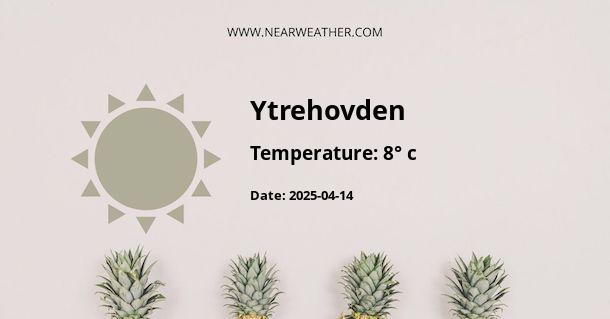Understanding the Climate and Weather Patterns of Ytre Hovden, Norway
Ytre Hovden is a location nestled in Norway, a country known for its dramatic landscapes and diverse climate zones. To comprehend the weather in Ytre Hovden, we must delve into its geographic position and explore the various climatological influences contributing to its unique weather patterns.
Geographic Location and Climate Influences
Ytre Hovden lies in a region characterized by a subarctic climate, known for its cool summers and long, cold winters. Two main factors shape the weather in this part of Norway: its high latitude and proximity to the Atlantic Ocean. Let's break these down in detail.
The subarctic climate zone marks a region where temperature thresholds delineate less pronounced seasonal changes compared to temperate zones, but more so than polar climates.
Seasonal Weather Conditions
Due to the seasonal tilt of the earth, Ytre Hovden experiences significant variations in daylight and temperature throughout the year.
- Winter: Characterized by heavy snowfall and temperatures that commonly fall below freezing, winter in Ytre Hovden extends from November to early March. The region receives polar nights, periods when the sun does not rise above the horizon.
- Spring: As spring arrives (usually between late March and May), snow begins to melt, and daylight rapidly increases. Temperatures become milder, but snow can linger or fall well into April.
- Summer: Lasting from June to August, summers are relatively cool with temperatures hovering near 15°C (59°F). This season benefits from the phenomenon known as the midnight sun, where the sun stays above the horizon for 24 hours.
- Autumn: From September to October, the weather cools significantly as Ytre Hovden transitions back into winter. This is a period of quickly diminishing daylight, with the first snowfalls often occurring in October.
Temperature and Precipitation Patterns
Let's look at the average temperature and precipitation patterns in Ytre Hovden, which give us a sense of the yearly consistency and variances in weather.
| Month | Average High | Average Low | Precipitation |
|---|---|---|---|
| January | -3°C (26.6°F) | -10°C (14°F) | 95mm (3.74in) |
| February | -2°C (28.4°F) | -9°C (15.8°F) | 75mm (2.95in) |
| March | 0°C (32°F) | -7°C (19.4°F) | 80mm (3.15in) |
| April | 3°C (37.4°F) | -3°C (26.6°F) | 70mm (2.76in) |
| May | 9°C (48.2°F) | 2°C (35.6°F) | 50mm (1.97in) |
| June | 13°C (55.4°F) | 6°C (42.8°F) | 60mm (2.36in) |
| July | 15°C (59°F) | 8°C (46.4°F) | 80mm (3.15in) |
| August | 14°C (57.2°F) | 7°C (44.6°F) | 90mm (3.54in) |
| September | 10°C (50°F) | 4°C (39.2°F) | 100mm (3.94in) |
| October | 4°C (39.2°F) | -1°C (30.2°F) | 110mm (4.33in) |
| November | -1°C (30.2°F) | -6°C (21.2°F) | 95mm (3.74in) |
| December | -3°C (26.6°F) | -9°C (15.8°F) | 85mm (3.35in) |
Please note that these figures are averages and actual conditions can vary considerably from year to year.
Wind, Cloud Cover, and Weather Events
Due to Ytre Hovden's coastal proximity, winds can play a significant role in day-to-day weather. Predominant winds from the west bring moist air from the Atlantic Ocean, leading to frequent cloud cover and precipitation. Moreover, these winds can intensify weather events, potentially causing storms especially during autumn and winter months.
- Northerly and Easterly Winds: When wind patterns shift, northerly or easterly winds can introduce colder, dryer air from the Arctic or the Russian hinterlands, respectively. These conditions can lower temperatures and decrease precipitation.
- Storms: Ytre Hovden is susceptible to powerful winter storms that can bring heavy snowfall or rain, high winds, and rough seas. These events require caution and preparedness from residents and visitors alike.
Unique Weather Phenomena
Ytre Hovden, like much of Norway, is also home to some unique and spectacular weather phenomena that draw interest worldwide.
- Northern Lights: Due to its high latitude, Ytre Hovden is an excellent location for viewing the Aurora Borealis, particularly in the winter months when nights are longest.
- Midnight Sun: During the peak summer months, the sun does not set below the horizon, offering 24 hours of daylight, a phenomenon that has significant impacts on daily life and wildlife activity.
- Polar Nights: Conversely, in the heart of winter, Ytre Hovden experiences days without a sunrise, known as polar nights, leading to extended periods of twilight and darkness.
The Impact of Climate Change on Ytre Hovden's Weather
As with many regions around the globe, climate change is affecting weather patterns in Ytre Hovden. Rising temperatures, melting glaciers, and shifting precipitation patterns are reshaping the landscape and potentially altering the long-established rhythms of the seasons. Scientific research indicates that Norway is experiencing warmer annual temperatures, changes in snowfall and ice cover, and more frequent extreme weather events, all of which have implications for local ecosystems, human activity, and the natural beauty that draws visitors to the region.
In summary, Ytre Hovden's weather is a complex interplay of latitude, terrestrial, and oceanic influences resulting in a subarctic climate with a rich tapestry of seasonal variations. The interplay between traditional weather patterns and contemporary climatic shifts ensures that Ytre Hovden remains a place of dynamic and compelling meteorological interest.
A - Ytrehovden's Latitude is 62.183331 & Longitude is 6.066670.
A - Weather in Ytrehovden is 8° today.
A - Climate Conditions in Ytrehovden shows light rain today.
A - Humidity in Ytrehovden is 93% today.
A - Wind speed in Ytrehovden is 3.71 km/h. today.
